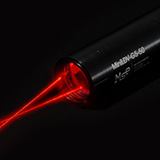| about | products | solutions | publications | contact | |
|
LDV/LDA microS microV miniPCS |
|
how an LDV/LDA works |
 |
Probe Volume CharacteristicsThe two beams must be focused at the probe volume to 1) create the smallest possible intersection zone (increasing the "brightness" of the light reflected by the particles), and 2) to ensure that the spacing between the fringes does not change much inside the probe volume. This critical alignment is easily maintained by the design of the miniLDV because both arms of the interferometer go through the same individual optics. There is always some "fringe divergence" as it is physically impossible to build a system in which the fringe spacing is absolutely constant within the probe volume. This is because the wavefront radius of the laser (according to beam propagation theory) is only zero at the waist, which is the exact focal point of the beam. All of MSE's LDV products are built to achieve the minimum possible fringe divergence. Fundamentally an LDV or LDA uses the same Doppler effect that causes the siren from an ambulance driving by to change pitch—except that here the Doppler effect is with light, not sound. However, there are two ways to interpret how an LDV or LDA is able to measure the speed of an object. The more intuitive explanation (see figure) goes as follows. How Speed is MeasuredThe fringes formed by the interference of the beams is a pattern of light in space. When a particle passes through the probe volume, it goes through the light and dark regions, so if its reflected light is measured as it travels along, the intensity versus time curve looks like a sinusoid with a Gaussian envelope. The Gaussian envelope comes from the fact that the intensity of the beams is Gaussian in nature. The sinusoid is the physical travel of the particle through the fringes. The physical distance between the fringes is known from the calibration which is performed with every probe. So the frequency of the intensity signal is directly proportional to the velocity of the particle: velocity = fringe spacing x intensity frequency. Although perhaps less intuitive, the measurement still works if the object passing through the probe volume is a continuous surface. This is because the probe volumes are so small that any microscopic features in the surface will reflect different amount of light and behave almost as if the surface were a stream of individual particles. To measure the velocity of fluids like air or water, there must be something in the fluid to reflect light back. In air the particles can be as small as the smoke particles of an incense stick; for water, sometimes there's enough signal straight out of the tap. |